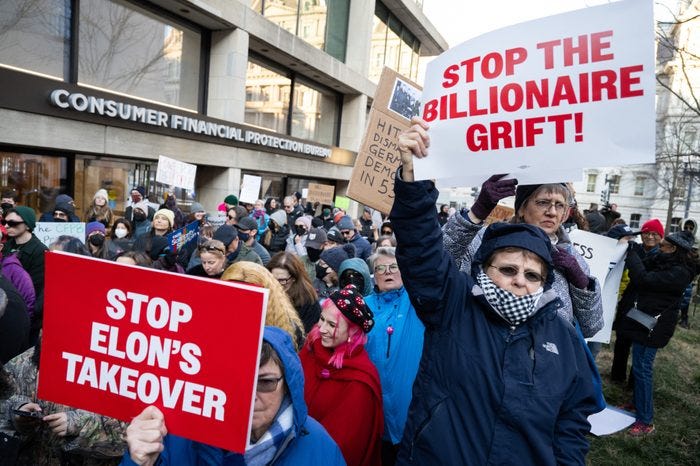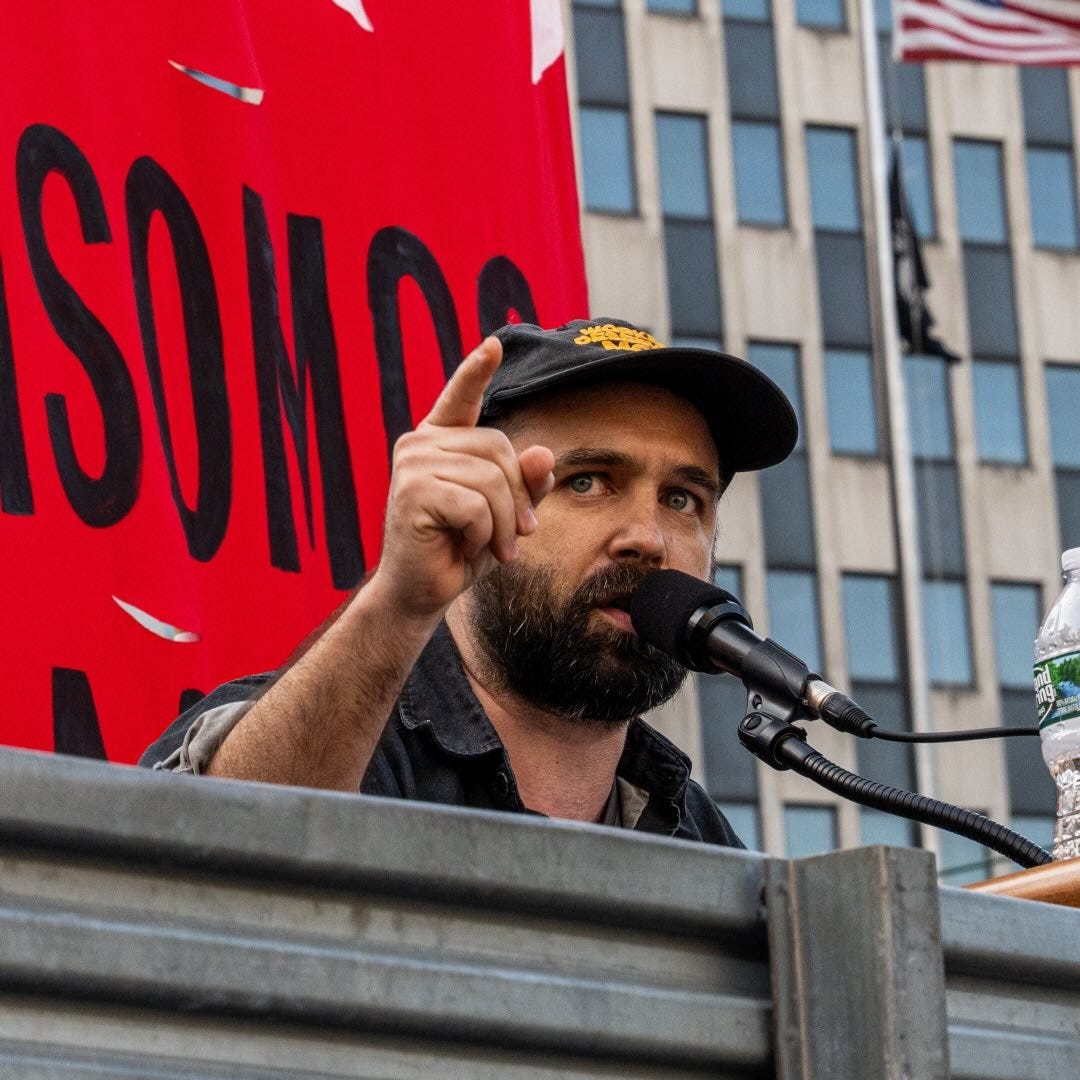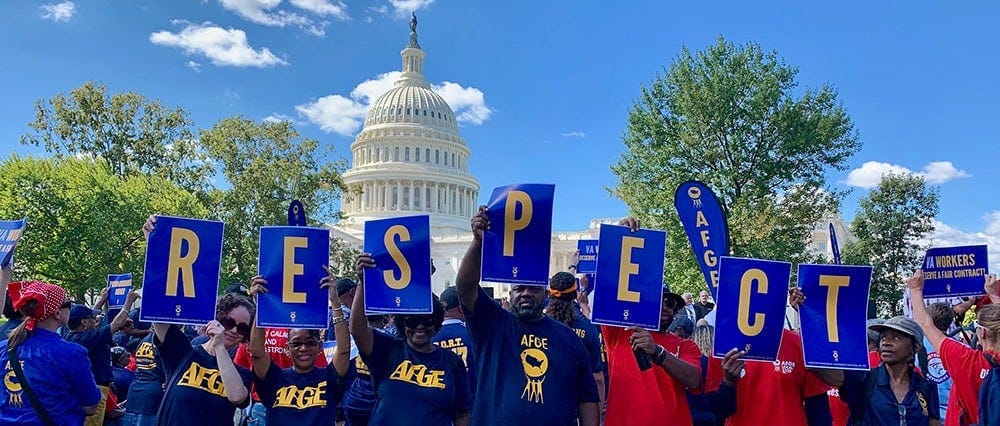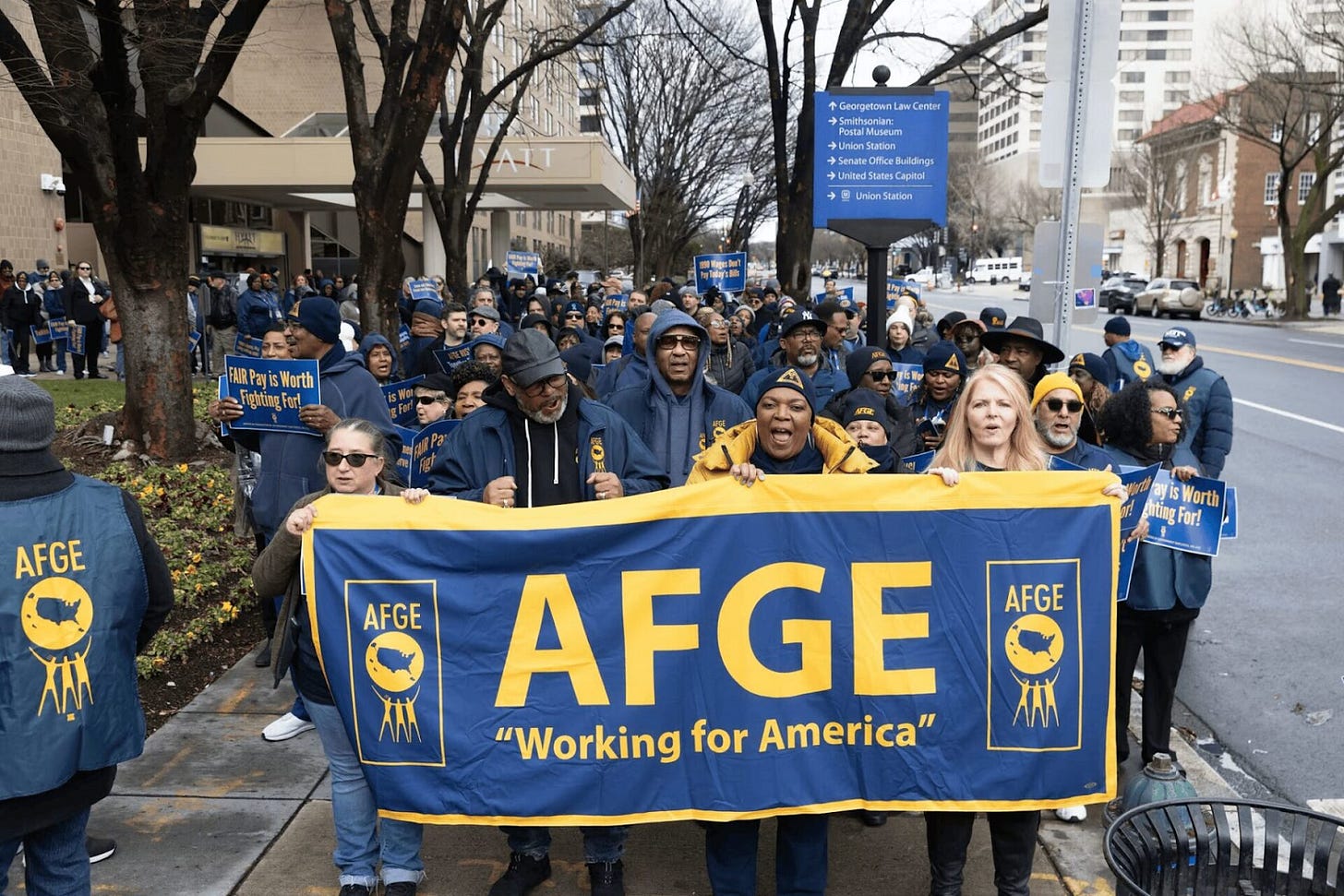In the Belly of the Beast: How the Federal Unionists Network is Fighting DOGE and Project 2025
On the Line interviewed Chris Dols, the co-Executive Director of the Federal Unionists Network (FUN), a network of unionists across the federal workforce fighting against the attacks on federal workers and the programs they administer. You can also listen to the full conversation as a podcast.
Jeff Rosenberg (JR): Elon Musk liked to talk about DOGE as a chainsaw to the federal government. Even with Musk out of the picture, the attacks haven’t stopped. Nearly 300,000 federal jobs have been cut, and they’re moving to dismantle or privatize key government services.
The Supreme Court recently sided again with the Trump administration, allowing them – for now – to continue slashing the federal workforce and restructuring the federal government. How does FUN understand these attacks? What’s really behind them?
Chris Dols (CD): We’ve said all along – these attacks aren’t about efficiency or national security. Those are just cover stories.
What’s really happening is a remaking of the civil service into a political arm of the administration. This is one part of a broader authoritarian strategy, driven by Trump and a Republican Party both working in full service to the billionaire agenda. It’s neoliberalism on steroids.
We’re watching a consolidation and acceleration of decades of privatization and deregulation. But this isn’t just about cutting government – it’s about transforming it. Yes, they’re slashing social services, but they’re also massively expanding violent coercive agencies like ICE and DHS. The goal is to politicize and weaponize the executive branch.
They’re creating a new kind of state, one that isn’t just corrupted by billionaires, but explicitly designed in their interests. It’s become a class war inside the government: public-minded civil servants on one side, billionaire appointees on the other.
JR: A lot of attention has gone to the spectacle of figures like Elon Musk, drawing constant media attention through outlandish stories. But people like Russell Vought, the chief architect of Project 2025, are often overlooked in all of this. Despite Trump's initial attempts to distance himself from Project 2025 during the elections, he's now fully embraced it as his blueprint for governance. Who is Vought and what role does he play?
CD: There’s definitely a spectacle layer to all this. You’ve got people like Musk, Oz, RFK grabbing headlines. But then you’ve got the real ideologues, the policy architects like Russell Vought, Stephen Miller, James Sherk. These are the guys quietly writing the rules.
Take Stephen Miller. Rumors are that he’s essentially running the show. The Chief of Staff runs the public-facing circus, and Miller runs the real agenda. That’s the division of labor we need to understand if we’re going to resist effectively.
Vought is key. He once said their goal was to make federal workers “wake up every day so traumatized they don’t want to go to work.” That’s their plan: to drive people out through deferred resignations, and now, thanks to the Supreme Court, through direct mass layoffs.
They want to shrink or destroy agencies that serve people, like Social Security or the VA, while bulking up the violent arms of the state. And they want to fill those agencies with their loyalists to carry out their mission.
JR: It’s no coincidence that some of these architects also identify as Christian Nationalists, a nicer way of say “white supremacists.” How do you see that ideology shaping this agenda?
CD: Stephen Miller is the perfect example. In high school, he ran for student government on the platform that the janitors weren’t doing enough and that they shouldn’t have to pick up their own trash. That’s his worldview! He thinks workers are just there to make rich kids’ lives easier.
Now he’s running the deportation strategy. His biggest frustration with the first Trump term? That the ICE raids didn’t separate enough families. They wanted to terrorize immigrant communities, to traumatize people into leaving or never coming here at all.
These are deeply violent people. Their white supremacy, this obsession with racial purity and anti-immigrant hatred, is just one part of a broader contempt for working people. To them, workers exist only to maximize profits for the rich and make their lives comfortable.
The “Christian” part is just decoration. The white nationalism builds their base. But ultimately, these are people who will pursue extreme violence if it serves their class interests.
That’s why the labor movement needs to get crystal clear about ICE raids. We need unions that aren’t as directly impacted, like many in the federal sector, to still take a stand. In the Federal Unionist Network, we’ve been organizing around exactly that.
Civil servants are citizens by necessity, so our workplaces haven’t traditionally been targeted. But that changed when federal buildings became the sites of immigration raids. Immigrants were lured to court dates in these buildings, only to have their cases dismissed so ICE could grab them on the way out. Pure bait-and-switch.
These kidnappings are happening in our lobbies, in our elevators. And we’re bearing witness. That’s why we’re calling on the rest of the labor movement to see what’s happening, not just as a separate immigration issue, but as a labor issue.
Even if your union isn’t directly impacted, the people in your community are. We need a cross-sector labor coalition to stand up and stop this.
JR: Part of the way the administration justifies these attacks is how they caricature federal workers – this image of “lazy bureaucrats in D.C. living large”. Can you set the record straight on who federal workers actually are and why their work matters?
CD: First, I want to say it’s not just Republicans. And when we talk about the Democrats undermining the federal government, the story goes deeper than just Clinton in the 90’s. Obama and Biden both contributed to the harm very directly too.
Obama froze federal pay for his first three years. That 27% wage gap between public and private sector workers? That’s mostly a result of his policies. Biden talked a good game on labor, but the federal workforce didn’t get a general counsel at FLRA, the agency that governs our labor rights, until year four. And now Trump’s already flipped it back.
The attack is bipartisan. The neglect is bipartisan.
As for who federal workers are? We’re park rangers keeping public lands safe. We’re EPA scientists testing water for lead. We’re VA nurses caring for veterans. We’re the ones who make sure this country functions.
And yet we’ve allowed the right wing to dominate the narrative. They claim the mantle of “government critic,” while Democrats have become the apparent defenders of government, again despite their actual actions. But real criticism of the government should come from us – federal workers who actually see the problems and know how to fix them. When public services fail, it’s not because they’re public. It’s because they’ve been deliberately undermined – through budget cuts, under-staffing, endless means-testing, or privatization.
But instead of empowering us to rebuild or speak out on these issues, we are told to be silent. And in that silence the political establishment hands that critique to the right, who use it to opportunistically and disingenuously justify dismantling everything. That’s why we need a different vision. We can’t just stop the attacks, but need to offer a new model for what the government can and should be.
JR: Part of that vision has to connect the workers with the programs they administer. These critical programs, like SNAP, Medicaid, and Social Security, came out of working-class struggle. These were victories of the Civil Rights movement, the Labor movement, and working people fighting back. But the right tries to pit workers against the very programs run for our benefit.
CD: Exactly. The attack on the workforce is the mechanism for dismantling the safety net. Take Social Security. The billionaire class wants that money in the stock market. It’s the largest and most successful public pension in our history. But they undermine it deliberately, then point and say, “See? It doesn’t work.”
A great example: the new bill eliminated the Social Security tax for tipped workers. Sounds good, right? It seems like a tax break for working people, but more analysis of it shows it really won’t help much at all and could leave people worse off. Beyond that, it’s a cynical move to further deplete the program’s funding, so later they can claim it’s insolvent and sell it off.
Every one of these moves comes wrapped in a “worker-friendly” lie. But the truth is obvious if you just scratch the surface. The problem is, too much of the media chases spectacle instead of substance. That’s why our unions, and projects like this one, have to break the silence.
JR: The same logic has gutted public education. First, underfund it. Then add impossible mandates. Then blame the system for failing. That justifies more charter schools, more testing, more cuts. This was practiced in New Orleans where after Hurricane Katrina, they have now privatized essentially all public education in the aftermath of that destruction. We have also seen real resistance to this agenda, with the Chicago Teachers Union offering a real path out of this crisis through their victories over the Charter movement there and the ongoing battle.
It’s the same playbook they are now using against federal workers, just a different sector. What lessons can we carry from those fights into the federal arena?
CD: You’re absolutely right. Education is the clearest example of this one-way right-wing ratchet attack. Decades of targeted privatization, starting in places like New Orleans after Katrina and Milwaukee even earlier, have devastated public education, especially for students of color.
But the fightback has grown alongside it. CTU’s victory was about reclaiming the idea that schools should serve communities, not profits and advancing the idea of bargaining for the common good. And the Red for Ed wave showed that resistance isn’t just for blue cities, but that it can catch fire in so-called red states too.
We can learn from both. First, that resistance is possible even under extreme right-wing governance. Second, that it requires unions to break out of their narrow lanes and take a stand on broader issues with the community. They fought these narratives head on and won over the community to organize with them by showing it was their fight too.
That’s the challenge for federal unions right now. For too long, many have sat out politics, or worse, become a passive wing of the Democratic Party. But we can’t afford that anymore. We need a labor movement that’s independent, militant, and honest about the failures of both parties. Our independence right now is going to be key to leading this fight and having credibility with working people.
Just look at New York. Labor is increasingly backing Zohran Mamdani against machine politicians like Andrew Cuomo, who couldn’t be a better representative of establishment Democratic politics. That’s a sign that people are ready to take on the establishment – left, right, or center.
The billionaire class always pushes its agenda through both parties. So we have to build a movement that doesn’t depend on either one to save us.

JR: One of the biggest attacks on the federal workforce has come with Trump’s attempts to strip nearly one million federal workers of their bargaining rights through an executive order. Why are they attempting to strip the federal workforce of their collective bargaining rights? And what do you make of the comparison to PATCO in 1981 when Reagan fired thousands of striking air traffic controllers?
CD: There were about a dozen departments or agencies who were covered, representing a majority of the union-represented federal workforce, and those attacks are all meant to make it easier to pursue mass layoffs that now the Supreme Court has green-lighted.
Ultimately, they see our unions as an obstacle to carrying out their agenda of restructuring the federal government. Our ability to protest and speak out against this in particular is very threatening to them. If they can ultimately rip up our collective bargaining rights, then they think we will have level power and protection to push back on any of this.
I think the PATCO comparison raises important questions for us about what we’ll do. PATCO became PATCO because of what followed, so we don’t know yet what this will become. I hope it can be the opposite. When Reagan broke the PATCO strike, it sent a signal to all employers and states that it was open season on unions. If they succeed in this attack, it could send a similar message.
But if we are able to successfully push back against this attack, then it can deal a critical defeat to Trump and show everyone that we can fight back.
We are also seeing them attempt to silence workers already who are speaking out against the ways in which they are dismantling these federal agencies and undermining our work. The workers at the Environmental Protection Agency who were recently put on administrative leave is a perfect example of this.
They signed a letter, speaking out against the current leadership of EPA directly undermining the mission. As a result, they were retaliated against. We are now drawing even more attention to this to highlight this fight to ensure they keep their jobs and can continue to speak out. It’s a clear illustration of our general strategy at FUN.
One of our initiatives we are launching soon is our oath renewal. The oath we take as civil servants to uphold the constitution had felt depoliticizing to be in the past, delivered alongside the pledge to not strike against the federal government. But right now when the administration is attempting to turn these institutions on their head it is a very political statement to renew our oath. We’ll be aiming to have hundreds of thousands of federal workers partake in this. In many ways, the EPA workers were in fact upholding their oath by signing on to the letter calling out the current EPA administration.
JR: As you mentioned earlier, the billionaires are trying to create an environment of fear and intimidation for federal workers to silence them and force them to submit. This organizing requires workers to overcome a lot of fear. How do you all approach that challenge?
CD: Whether it's because you're organizing a union in your 10 person coffee shop or if you're organizing to resist the oligarchy in the 2.3 million person federal workforce, it's basically the same formula, which is you bring workers together, find their common grievances. You identify whatever the initial steps are that people are willing to take together to at least identify the next layer of workers who are willing to join you. You inoculate each other against the likely response from management to prepare them for what’s coming.
And generally we need to be organizing with a new intensity that we haven’t seen in generations. We have a lot of work to do, but we aren’t starting from scratch and there are more class-conscious unionists today than we’ve seen in years.
We also need to make sure we aren’t getting caught up in finger pointing or I-told-you-so’s. Many of us may have criticisms of our unions and how we have approached organizing or not in the past, but we need to let that be water under the bridge right now. Many of those same leaders are recognizing the need to organize now and we need to unite everyone who can be united.
JR: Crises can be very clarifying for everyone, including leaders and members. They force everyone to make a choice – stay on the sidelines, or step into the fight. So what’s next? What’s FUN focused on now?
CD: Mass participation is everything. We can’t predict what the next big tactic will be, but we know what kind of movement we need: one that’s escalating, political, and rooted in solidarity across all sections of our class.
For example, we’ve organized informational pickets that bring federal workers together with immigrant communities, especially as our workplaces have become the sites of ICE raids. That’s a major step forward. Things like our informational pickets may not look “militant” in the traditional sense, but for a lot of people, standing outside a federal building and speaking up is a huge leap. And it’s opening new doors.
These actions don’t just show solidarity with immigrant workers. They also push federal workers to see themselves as part of a broader class struggle. That’s how we build momentum, by taking small, brave steps that lead to bigger ones.
And we need to think ahead. Right now, they’re targeting immigrants. But next, it’ll be veterans, seniors, and everyone who relies on the public programs they’re trying to destroy. These people hate anyone who isn’t a billionaire. We need to unite all of their targets into a single movement.
JR: Before we wrap up, is there a final message of hope you want to leave us with?
CD: My hope comes from the people who are organizing right now, despite the fear, despite the risk. I’ve seen so many federal workers take bold action in the face of retaliation. That gives me hope.
And our unions, if we can get them to act together, across agencies, with a clear strategy to expose and oppose this administration’s agenda. We can shift public opinion. We can show people what’s at stake and what’s possible.
For anyone listening who’s a federal worker: get involved in your union. Help build it into the kind of fighting force we need. For everyone else: visit SafePublicServices.com. That will take you to our Action Network page where you can sign up to join rapid response efforts. Tens of thousands of people already have.
The most important thing is this: federal workers touch everything. We’re in a strategic position, not by accident, but because the administration made us a primary target. That means we have to be a primary line of defense.
If we build strong, participatory unions, and if we fight in open solidarity with everyone this government is attacking, then we can turn the tide. We have no choice but to fight.
Check out the full conversation in our latest podcast episode.










Follow the money….
This is a short list of affiliations connected to Project 2025:
Heritage Foundation, Heritage Action Plan for America,, Project 2025, MAGA, American companies donors to far right ideology, BBB 2025, Russell VOUGHT, Kevin Roberts, STEPHEN Miller, January 6, 2021, insurrectionist, pardoned insurrectionist, America First Policy Institute, Charlie Kirk, Turning Point USA, billionaires, corporations, greed, corruption, power, GOP.
Heritage foundation available in 32 languages, heritage action plan for America available in 31 languages, project 2025 available in 7 languages.